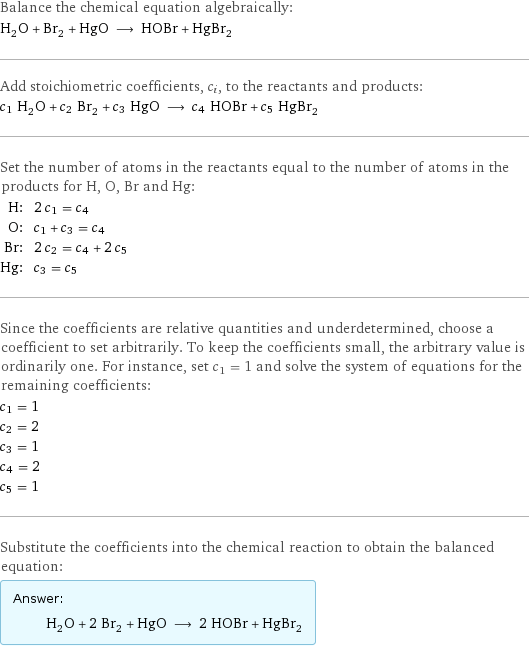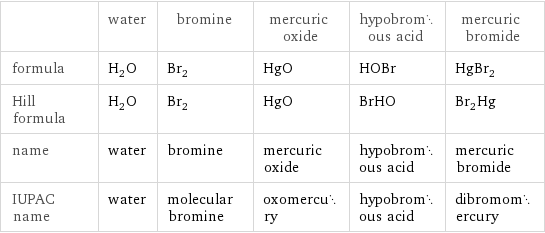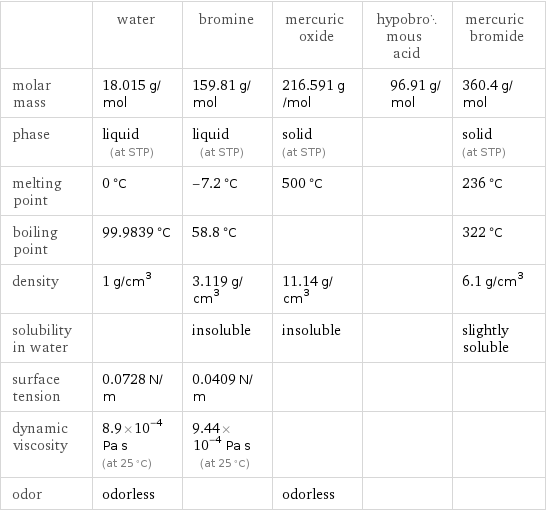Input interpretation

H_2O water + Br_2 bromine + HgO mercuric oxide ⟶ HOBr hypobromous acid + HgBr_2 mercuric bromide
Balanced equation

Balance the chemical equation algebraically: H_2O + Br_2 + HgO ⟶ HOBr + HgBr_2 Add stoichiometric coefficients, c_i, to the reactants and products: c_1 H_2O + c_2 Br_2 + c_3 HgO ⟶ c_4 HOBr + c_5 HgBr_2 Set the number of atoms in the reactants equal to the number of atoms in the products for H, O, Br and Hg: H: | 2 c_1 = c_4 O: | c_1 + c_3 = c_4 Br: | 2 c_2 = c_4 + 2 c_5 Hg: | c_3 = c_5 Since the coefficients are relative quantities and underdetermined, choose a coefficient to set arbitrarily. To keep the coefficients small, the arbitrary value is ordinarily one. For instance, set c_1 = 1 and solve the system of equations for the remaining coefficients: c_1 = 1 c_2 = 2 c_3 = 1 c_4 = 2 c_5 = 1 Substitute the coefficients into the chemical reaction to obtain the balanced equation: Answer: | | H_2O + 2 Br_2 + HgO ⟶ 2 HOBr + HgBr_2
Structures

+ + ⟶ +
Names

water + bromine + mercuric oxide ⟶ hypobromous acid + mercuric bromide
Equilibrium constant
![Construct the equilibrium constant, K, expression for: H_2O + Br_2 + HgO ⟶ HOBr + HgBr_2 Plan: • Balance the chemical equation. • Determine the stoichiometric numbers. • Assemble the activity expression for each chemical species. • Use the activity expressions to build the equilibrium constant expression. Write the balanced chemical equation: H_2O + 2 Br_2 + HgO ⟶ 2 HOBr + HgBr_2 Assign stoichiometric numbers, ν_i, using the stoichiometric coefficients, c_i, from the balanced chemical equation in the following manner: ν_i = -c_i for reactants and ν_i = c_i for products: chemical species | c_i | ν_i H_2O | 1 | -1 Br_2 | 2 | -2 HgO | 1 | -1 HOBr | 2 | 2 HgBr_2 | 1 | 1 Assemble the activity expressions accounting for the state of matter and ν_i: chemical species | c_i | ν_i | activity expression H_2O | 1 | -1 | ([H2O])^(-1) Br_2 | 2 | -2 | ([Br2])^(-2) HgO | 1 | -1 | ([HgO])^(-1) HOBr | 2 | 2 | ([HOBr])^2 HgBr_2 | 1 | 1 | [HgBr2] The equilibrium constant symbol in the concentration basis is: K_c Mulitply the activity expressions to arrive at the K_c expression: Answer: | | K_c = ([H2O])^(-1) ([Br2])^(-2) ([HgO])^(-1) ([HOBr])^2 [HgBr2] = (([HOBr])^2 [HgBr2])/([H2O] ([Br2])^2 [HgO])](../image_source/56dea01bc4bdbeb0ec51152919b5c690.png)
Construct the equilibrium constant, K, expression for: H_2O + Br_2 + HgO ⟶ HOBr + HgBr_2 Plan: • Balance the chemical equation. • Determine the stoichiometric numbers. • Assemble the activity expression for each chemical species. • Use the activity expressions to build the equilibrium constant expression. Write the balanced chemical equation: H_2O + 2 Br_2 + HgO ⟶ 2 HOBr + HgBr_2 Assign stoichiometric numbers, ν_i, using the stoichiometric coefficients, c_i, from the balanced chemical equation in the following manner: ν_i = -c_i for reactants and ν_i = c_i for products: chemical species | c_i | ν_i H_2O | 1 | -1 Br_2 | 2 | -2 HgO | 1 | -1 HOBr | 2 | 2 HgBr_2 | 1 | 1 Assemble the activity expressions accounting for the state of matter and ν_i: chemical species | c_i | ν_i | activity expression H_2O | 1 | -1 | ([H2O])^(-1) Br_2 | 2 | -2 | ([Br2])^(-2) HgO | 1 | -1 | ([HgO])^(-1) HOBr | 2 | 2 | ([HOBr])^2 HgBr_2 | 1 | 1 | [HgBr2] The equilibrium constant symbol in the concentration basis is: K_c Mulitply the activity expressions to arrive at the K_c expression: Answer: | | K_c = ([H2O])^(-1) ([Br2])^(-2) ([HgO])^(-1) ([HOBr])^2 [HgBr2] = (([HOBr])^2 [HgBr2])/([H2O] ([Br2])^2 [HgO])
Rate of reaction
![Construct the rate of reaction expression for: H_2O + Br_2 + HgO ⟶ HOBr + HgBr_2 Plan: • Balance the chemical equation. • Determine the stoichiometric numbers. • Assemble the rate term for each chemical species. • Write the rate of reaction expression. Write the balanced chemical equation: H_2O + 2 Br_2 + HgO ⟶ 2 HOBr + HgBr_2 Assign stoichiometric numbers, ν_i, using the stoichiometric coefficients, c_i, from the balanced chemical equation in the following manner: ν_i = -c_i for reactants and ν_i = c_i for products: chemical species | c_i | ν_i H_2O | 1 | -1 Br_2 | 2 | -2 HgO | 1 | -1 HOBr | 2 | 2 HgBr_2 | 1 | 1 The rate term for each chemical species, B_i, is 1/ν_i(Δ[B_i])/(Δt) where [B_i] is the amount concentration and t is time: chemical species | c_i | ν_i | rate term H_2O | 1 | -1 | -(Δ[H2O])/(Δt) Br_2 | 2 | -2 | -1/2 (Δ[Br2])/(Δt) HgO | 1 | -1 | -(Δ[HgO])/(Δt) HOBr | 2 | 2 | 1/2 (Δ[HOBr])/(Δt) HgBr_2 | 1 | 1 | (Δ[HgBr2])/(Δt) (for infinitesimal rate of change, replace Δ with d) Set the rate terms equal to each other to arrive at the rate expression: Answer: | | rate = -(Δ[H2O])/(Δt) = -1/2 (Δ[Br2])/(Δt) = -(Δ[HgO])/(Δt) = 1/2 (Δ[HOBr])/(Δt) = (Δ[HgBr2])/(Δt) (assuming constant volume and no accumulation of intermediates or side products)](../image_source/f0407b6c64b79006ad852546d4658f2f.png)
Construct the rate of reaction expression for: H_2O + Br_2 + HgO ⟶ HOBr + HgBr_2 Plan: • Balance the chemical equation. • Determine the stoichiometric numbers. • Assemble the rate term for each chemical species. • Write the rate of reaction expression. Write the balanced chemical equation: H_2O + 2 Br_2 + HgO ⟶ 2 HOBr + HgBr_2 Assign stoichiometric numbers, ν_i, using the stoichiometric coefficients, c_i, from the balanced chemical equation in the following manner: ν_i = -c_i for reactants and ν_i = c_i for products: chemical species | c_i | ν_i H_2O | 1 | -1 Br_2 | 2 | -2 HgO | 1 | -1 HOBr | 2 | 2 HgBr_2 | 1 | 1 The rate term for each chemical species, B_i, is 1/ν_i(Δ[B_i])/(Δt) where [B_i] is the amount concentration and t is time: chemical species | c_i | ν_i | rate term H_2O | 1 | -1 | -(Δ[H2O])/(Δt) Br_2 | 2 | -2 | -1/2 (Δ[Br2])/(Δt) HgO | 1 | -1 | -(Δ[HgO])/(Δt) HOBr | 2 | 2 | 1/2 (Δ[HOBr])/(Δt) HgBr_2 | 1 | 1 | (Δ[HgBr2])/(Δt) (for infinitesimal rate of change, replace Δ with d) Set the rate terms equal to each other to arrive at the rate expression: Answer: | | rate = -(Δ[H2O])/(Δt) = -1/2 (Δ[Br2])/(Δt) = -(Δ[HgO])/(Δt) = 1/2 (Δ[HOBr])/(Δt) = (Δ[HgBr2])/(Δt) (assuming constant volume and no accumulation of intermediates or side products)
Chemical names and formulas

| water | bromine | mercuric oxide | hypobromous acid | mercuric bromide formula | H_2O | Br_2 | HgO | HOBr | HgBr_2 Hill formula | H_2O | Br_2 | HgO | BrHO | Br_2Hg name | water | bromine | mercuric oxide | hypobromous acid | mercuric bromide IUPAC name | water | molecular bromine | oxomercury | hypobromous acid | dibromomercury
Substance properties

| water | bromine | mercuric oxide | hypobromous acid | mercuric bromide molar mass | 18.015 g/mol | 159.81 g/mol | 216.591 g/mol | 96.91 g/mol | 360.4 g/mol phase | liquid (at STP) | liquid (at STP) | solid (at STP) | | solid (at STP) melting point | 0 °C | -7.2 °C | 500 °C | | 236 °C boiling point | 99.9839 °C | 58.8 °C | | | 322 °C density | 1 g/cm^3 | 3.119 g/cm^3 | 11.14 g/cm^3 | | 6.1 g/cm^3 solubility in water | | insoluble | insoluble | | slightly soluble surface tension | 0.0728 N/m | 0.0409 N/m | | | dynamic viscosity | 8.9×10^-4 Pa s (at 25 °C) | 9.44×10^-4 Pa s (at 25 °C) | | | odor | odorless | | odorless | |
Units
